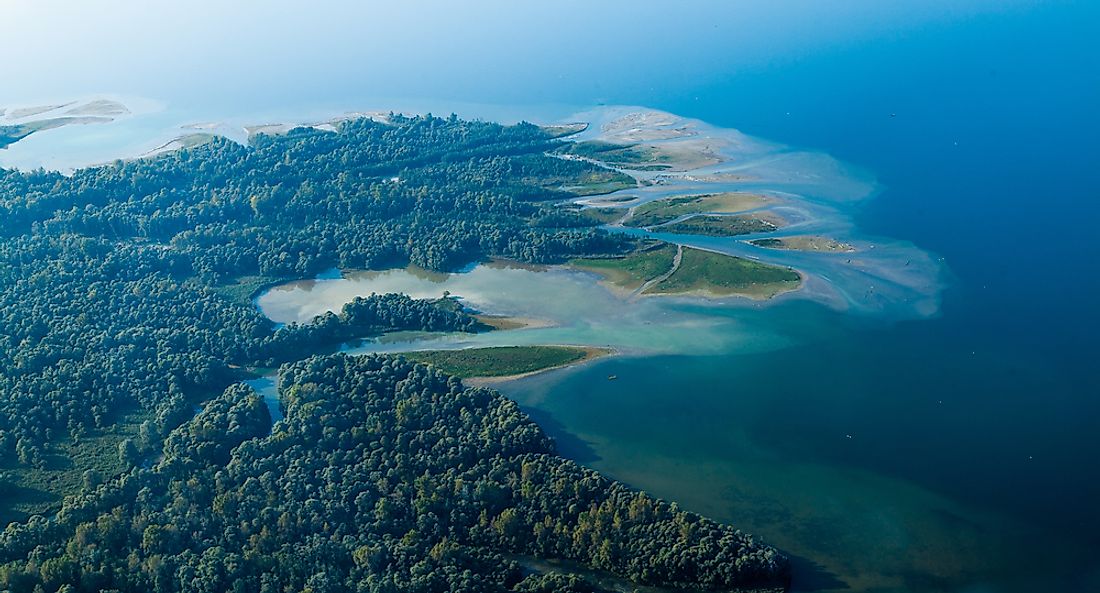Where Is The Largest Delta In The World?

What Is A River Delta?
A river delta is formed by the deposition of sediments transported by a river as the flow leaves its mouth and enters still waters or slow-moving waters. Deltas are often formed where a river enters another water body including oceans, lakes, sea, or reservoir. Deltas are ecologically significant as they defend the coastline and offer habitats for several species. Deltas are classified into wave-dominated deltas, tide-dominated deltas, inland deltas, estuaries, and Gilbert deltas. The delta formation process is complex and occurs over time. Several river deltas are scattered across the world including Ganges-Brahmaputra Delta, the world’s largest.
The Ganges Delta
Ganges Delta, officially known as Ganges-Brahmaputra or the Bengal Delta, is located in the Bengal region of Indian subcontinent which consists of the Indian state of West Bengal and the country of Bangladesh. The delta is the largest in the world and one of the most fertile regions of the in the world hence the name the Green Delta. The Ganges Delta empties into the Bay of Bengal and stretches from the Hooghly River to the Meghan River. The principal seaports of the delta include Kolkata, Haldia, Mongla, and Chittagong. Several large rivers large rivers flow through the delta including Padma and Jamuna which are the main distributaries of Ganges and Brahmaputra respectively.
Geography Of The Ganges Delta
The Bengal Delta assumes the shape of a triangle and is considered to be arc-shaped. The delta has a surface area of about 41,000 square miles. The width of the delta along the coast is approximately 217 miles while the distance from the confluence of Ganges and Brahmaputra to the coast is about 155 miles. Two-thirds of the delta lies in Bangladesh while the rest of the delta is part of the state of West Bengal, India. The delta is the floodplain of three rivers including Ganges, Megna, and Brahmaputra with the three rivers draining a catchment of about 665,000 square miles on the southern side of the Himalaya. The Ganges Delta is one of the most fertile regions of the earth and is composed of alluvial soil which is rich in minerals and nutrients suitable for agriculture. The delta is composed of channels, swamp, lakes, and floodplains. It is divided into two parts by the Gorai-Madhumati River with the eastern side more geologically active than the western side.
Wildlife Of The Ganges Delta
The Ganges Delta is covered by three terrestrial ecoregions: the moist deciduous forest of the lower Gangetic plain, the Sundarbans swamp forest, and the Sunderbans mangrove. Most of the forests have been cleared for agriculture with only thick tall grass dominating the deciduous forest ecoregion. The Sunderbans mangrove forms the world’s largest mangrove ecoregion covering an area of approximately 8,000 square miles. Some of the animals of the Ganges Delta include Indian pythons, Indian elephant, crocodiles, and Bengal tigers. The delta is also characterized by several birds including kingfisher, eagles, and woodpeckers.
Economic Importance
Ganges Delta is one of the most densely populated areas in the world with a population of about 140 million people. Agriculture is the main economic activity in the area with the major crops grown including rice, tea, and jute. Fishing is also a major economic activity in the Ganges Delta.











